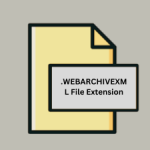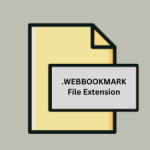.PHP File Extension

What is an PHP file?
The .php file extension is used for files containing PHP code, which stands for Hypertext Preprocessor. PHP is a widely-used, open-source scripting language especially suited for web development. PHP files typically contain a mix of HTML, CSS, JavaScript, and PHP code that is processed on the server to generate dynamic web content.
More Information.
PHP was initially developed as a set of CGI binaries written in the C programming language to track visitors to Lerdorf’s online resume. It was designed to enable the creation of dynamic web pages. The language has evolved from a basic tool into a powerful scripting language capable of handling complex web applications, thanks to successive releases and enhancements over the years.
Origin Of This File.
PHP was created by Danish-Canadian programmer Rasmus Lerdorf in 1993. Originally named “Personal Home Page,” PHP was later rebranded to “PHP: Hypertext Preprocessor,” a recursive acronym. The language has evolved significantly over the years, with contributions from many developers and the support of the PHP Group.
File Structure Technical Specification.
- File Extension:
.php - File Type: Text file containing PHP code
How to Convert the File?
Windows
- Convert PHP Output to HTML:
- Run the PHP file on a local server (e.g., using XAMPP or WAMP).
- Access the PHP file via a web browser (e.g.,
http://localhost/yourfile.php). - Save the generated HTML from the browser using “Save Page As.”
- Convert PHP Output to PDF:
- Use PHP libraries like TCPDF or FPDF in your PHP script to generate PDFs directly.
- Run the script on your local server to create the PDF.
- Convert PHP to Another File Type:
- If your PHP script generates specific outputs (e.g., CSV files), configure the script to produce those formats.
- Run the script and download the resulting files.
Linux
- Convert PHP Output to HTML:
- Set up a local server using the LAMP stack.
- Access your PHP script through the browser to generate HTML.
- Save the HTML output from the browser.
- Convert PHP Output to PDF:
- Utilize PHP libraries like TCPDF or Dompdf to generate PDFs from your PHP script.
- Execute the script on your server to produce the PDF file.
- Convert PHP to Another File Type:
- Adjust your PHP code to export different file formats (e.g., CSV, JSON).
- Run the script to create the file, which you can then access or download.
macOS
- Convert PHP Output to HTML:
- Install MAMP or use a similar local server environment.
- Run your PHP file via the local server and save the HTML output from the browser.
- Convert PHP Output to PDF:
- Incorporate PDF generation libraries in your PHP code.
- Execute the script to produce the PDF.
- Convert PHP to Another File Type:
- Modify your PHP script to output the desired file type.
- Access the script through the server environment and save the output.
Android
- Convert PHP Output to HTML:
- It’s challenging to run PHP on Android directly. Use an external server to run the PHP script.
- Access the output in a browser and save it as HTML.
- Convert PHP Output to PDF:
- Similar to HTML, run your PHP script on an external server to generate PDFs.
- Download or view the PDF through the browser on your Android device.
- Convert PHP to Another File Type:
- Use the server to generate files (like CSV) and download them to your Android device.
iOS
- Convert PHP Output to HTML:
- Run the PHP file on a server and access it through Safari or another browser.
- Save the HTML content using the browser’s options.
- Convert PHP Output to PDF:
- Use PHP libraries to generate PDF files on your server.
- Download the PDF file via the browser on your iOS device.
- Convert PHP to Another File Type:
- Adjust the PHP script to generate files like CSV or JSON.
- Access and download these files through your browser.
Others
- Convert PHP Output to HTML/PDF/Other Formats:
- Use a web server that supports PHP, accessible from any device or environment.
- Generate the output (HTML, PDF, etc.) using PHP code and save or download the resulting files as needed.
- Handling PHP Files Directly:
- Use text editors or IDEs compatible with PHP to view or edit PHP files in any environment.
- For server environments, ensure that PHP is installed and properly configured.
Advantages And Disadvantages.
Advantages:
- Server-Side Execution: PHP runs on the server, which means code execution happens on the server-side, reducing the load on the client’s machine.
- Open Source: PHP is free to use, and there is a vast community for support.
- Integration: It integrates well with various databases, such as MySQL and PostgreSQL.
- Flexibility: PHP code can be mixed with HTML, CSS, and JavaScript to create dynamic web pages.
Disadvantages:
- Performance: PHP may have performance limitations compared to some newer technologies or languages.
- Security Risks: PHP applications can be vulnerable to security issues if not properly coded, such as SQL injection or cross-site scripting (XSS).
- Inconsistent Function Naming: Some developers find the function names in PHP inconsistent or unintuitive.
How to Open PHP?
Open In Windows
- Text Editors: PHP files can be opened and edited with text editors like Notepad++, Sublime Text, or Visual Studio Code.
- IDE: Integrated Development Environments like PHPStorm or NetBeans provide advanced features for PHP development.
- Web Server: PHP files need to be executed on a local or remote server running PHP. Software like XAMPP or WAMP can set up a local server environment on Windows.
Open In Linux
- Text Editors: You can use text editors such as Vim, Nano, or graphical editors like Gedit and VSCode.
- IDE: PHPStorm, NetBeans, or Eclipse PDT can be used for development.
- Web Server: Linux users can use LAMP (Linux, Apache, MySQL, PHP) stack to run PHP files locally.
Open In MAC
- Text Editors: PHP files can be opened with TextEdit, Sublime Text, or VSCode on macOS.
- IDE: Development environments like PHPStorm or NetBeans are available for macOS.
- Web Server: macOS users can install MAMP to set up a local PHP development environment.
Open In Android
- Text Editors: While Android devices are not commonly used for PHP development, text editors like AIDE or Quoda can open and edit PHP files.
- Web Server: Running PHP files requires a server environment, which can be tricky on Android. Some apps may offer local server capabilities for testing purposes.
Open In IOS
- Text Editors: Apps like Textastic or Koder can open and edit PHP files on iOS devices.
- Web Server: Similar to Android, running a PHP server directly on iOS is challenging. Remote server access through apps or services is typically required for executing PHP code.
Open in Others
- Web Browsers: PHP files cannot be directly opened in web browsers; they need to be served by a PHP-enabled web server.
- Code Editors and IDEs: Most modern code editors and IDEs support PHP and can be used to view and edit
.phpfiles, regardless of the operating system.













